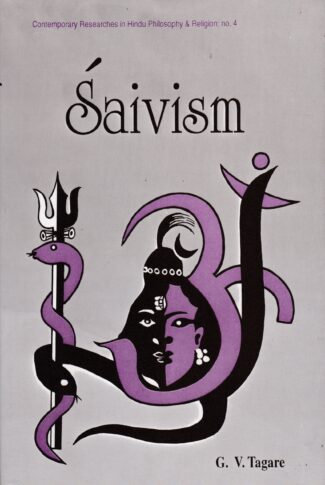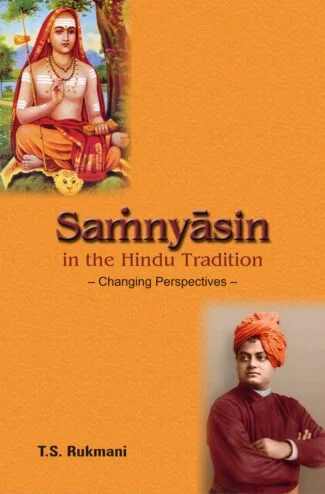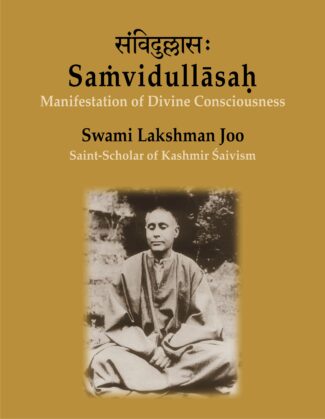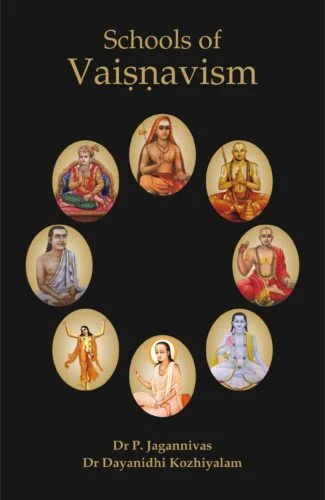Showing 85–96 of 142 results

Dr. Tagares book unfolds the essence of Saivism and its principal philosophical expressions. Spelling out Saivisms fundamental concepts, it offers a discussion of the major agama-based Saiva Schools besides the Vedic Pasupatism.
Along with Brahma and Vishnu, Shiva makes the Hindu trinity: the trimurti. The name, Shiva signifies auspiciousness. But he is Rudra: the fierce, as well. Often looked upon as the principle of cosmic destruction, he also creates and reproduces. In abstract terms, Shiva is the first cause, the source of consciousness, the very substratum of the universe. Shaivism: the worship of Shiva, is not just a dominant religious tradition. It is also a philosophy which, over the centuries, has evolved metaphysical doctrines on different issues of universal concern, specially the nature of Reality: Shiva (pati), and of its interrelatedness with the Individual Soul (jivatman/pashu) and the world at large. Dr. Tagares book is a brilliant effort to quintessentially unfold Shaivism and its principal philosophical expressions. Spelling out a range of fundamental concepts like, for instance, pati (Shiva), pashu (individual soul), and moksha (liberation), the author offers a stimulating, highly systematic discussion of the major, agama-based Shaiva Schools, namely, Kashmir Shaivism, Siddhanta Shaivism, Shivadvaita (or Shaiva Vishishtadvaita of Shrikantha), and Vira-Shaivism (or Shakti-Vishishtadvaita); besides the Vedic Pashupatism with emphasis on how one school of Shaiva thought differs from the other. Finally describing some of its syncretic forms, Dr. Tagare demonstrates how Shaivism, through a balanced synthesis of yoga, karma and bhakti, inheres a strong relevance to the tension-riven world of our times. Together with a glossary of Sanskrit terms and many bibliographic references, the book holds out a lasting appeal to the scholars of Indology, traditional Indian philosophy, and religion.

The worship of Shakti (Mother Goddess) is almost a universal phenomenon and its manifestation is seen in different forms. This book incorporates a number of papers on multiple aspects of øàkta traditions practised in Varanasi continuing from hoary past to-date.
The worship of Shakti (mother Goddess) is almost a universal phenomenon and its manifestation is seen in different forms. Indian contribution has also been laudable and it is amply noticed through the figures of Mother-Goddesses even from the pre-Indus Culture. This was followed in the subsequent ages throughout India, and Varanasi being a great religious centre has also left an indelible imprint in this regard. This book incorporates a good number of papers on multiple aspects of Shakta traditions practised in Varanasi continuing from hoary past to-date. Beside philosophical, religious and cultural leanings the contents expose the iconographic, ritualistic and artistic rendering of the Divine Mother. Kashi or Varanasi has been a stronghold of religious and spiritual fervour; and several religious sects have contributed to its present texture. Saktism has also been a forceful current in the cultural stream of this holy city. This is evidenced by several Devi temples, Shakti-pithas, yantras, fairs and festivals associated with the worship of Mother-Goddess.

This study, in an ethono-historical perspective, explores the multi linear evolution of Sakti worship in Orissa: from the pre-/protohistorical times to the late medieval epoch, and its continuity into the modern period with contextual focus on its probable genesis, historical development, festivals, ritualistic patterns, and cultural sources including myths, legends and folklore.
In the Hindu world-view, Shakti is the Mother of the Universe: the highest primal power. She is, accordingly, the all-pervading, intagible energy principle that propels the cosmos and its endless human dimensions with the life-throbs of activity and culture. Many are her songs, countless her stories, numerous her names. Worship of Shakti, as a pan-Indian phenomenon, predates Sanskritic influences of every kind. Combining his extensive fieldwork with diverse published and unpublished sources: archaeological, historical and religious, Francesco Brighentis study traces its presence in Orissa. Which, perhaps, provides the best paradigm of an age-old Goddess cult, deeply rooted in the autochthonous religious traditions of Eastern India. It is the first, all-encompassing study, in an ethono-historical perspective, exploring the multilinear evolution of Shakti worship in Orissa: from the pre-/proto- historical times to the late medieval epoch, and even its continuity into the modern period with contextual focus on its probable genesis, historical development, festivals, ritualistic patterns, and cultural sources including myths, legends and folklore. The book also incorporates, besides a description of important Shakta centres in Orissa, a study of the Divine Mothers iconographic features in Her multifarious manifestations. Together with around hundred illustrations highlighting the varied representations of Shakti in sculpture, this study will interest not only the scholars of archaeology, history and religion, but historians of art as well.

This book tries to look at samnyasins and the samnyasashrama in their long existence from the times of Shankara to the present day and also throws light on how scholars, common people, as well as the samnyasins themselves view their roles, both as individual personalities and as persons living in an institution relating to society as a whole.
The present book, Samnyasins in the Hindu Tradition: Changing Perspectives, covers a wide territory, trying to look at the samnyasins and the samnyasashrama in their long existence from the times of Shankara to the present day. This book traverses a slightly different trajectory from the usual book on samnyasins as it attempts an overview of the samnyasin and the institution over a long period from Vedic to post-Independence times and speculates on the future of the institution as well. Samnyasins and scholars not only from India, but from countries as diverse as Canada, South Africa, UK and USA also figure in this collection. The samnyasashramas covered also range from the traditional Advaita, Vishishthadvaita and Dvaita to include many more later ashrams such as the Vira Shaiva (Lingayat), Dharmapuram Adheenam, Arya Samaj, Shivananda Ashram, Ramakrishna Mission, Swami Narayan and many others. Another departure from other books on the subject is that it also compares institutions like the Ramakrishna Mission for instance, as they function in India and in foreign countries where they have established ashrams. In the midst of varied opinions regarding the samnyasin and the samnyasashrama this book will throw light on how scholars, common people, as well as the samnyasins themselves view their roles, both as individual personalities and as persons living in an institution relating to society as a whole.

This volume is a Birth Centenary tribute to Swami Lakshman Joo Raina (1907-1991), a great saint and scholar of Kashmir, who revived the tradition of Kashmir Shaivism. The articles by scholars, disciples and devotees reflect on his life and work, and on his spiritual influence.
Swami Lakshman Joo Raina, also called Lakshman Brahmacarin and Ishvara Svarupa (1907Ý1991) was one of the greatest saints of 20th century India, who was at the same time an extraordinary scholar who relived and revived the almost forgotten tradition of Kashmir Shaivism. His high spiritual state was matched by his profound knowledge of the Shaiva scriptures and of the great thinkers and commentators of the tradition Þ Abhinavagupta, Kshemaraja and others. Swami Lakshman Joo lived a secluded life in his ashram in Kashmir, but he taught the texts of Kashmir Shaivism to Pandits and scholars from different countries, besides giving spiritual guidance to a number of seekers and disciples. On the occasion of his Birth Centenary, a volume in his memory is being brought out containing articles by scholar-disciples, devotees and relatives which throw light on the extraordinary life of this saint and on his contribution to reviving and continuing the tradition of Kashmir Shaivism. Articles on his life by his close disciple Prabha Devi and his scholar-disciples Jaideva Singh and Jankinath Kaul `Kamal’, an exhaustive article on his place in the Kashmirian Shaiva tradition by Professor Alexis Sanderson of Oxford, to mention only a few, provide an insight into his saintly personality and his great qualities as a teacher. Even scholars and seekers who have never met him and have been deeply influenced by his spiritual presence have contributed an account of their experience. The volume is richly illustrated by historical photographs which provide a visual testimony of the life of Swami Lakshman Joo. A list of his published works is an important complement.

This volume is a Birth Centenary tribute to Swami Lakshman Joo Raina (1907-1991), a great saint and scholar of Kashmir, who revived the tradition of Kashmir Shaivism. The articles by scholars, disciples and devotees reflect on his life and work, and on his spiritual influence.
Swami Lakshman Joo Raina, also called Lakshman Brahmacarin and Ishvara Svarupa (1907Ý1991) was one of the greatest saints of 20th century India, who was at the same time an extraordinary scholar who relived and revived the almost forgotten tradition of Kashmir Shaivism. His high spiritual state was matched by his profound knowledge of the Shaiva scriptures and of the great thinkers and commentators of the tradition Þ Abhinavagupta, Kshemaraja and others. Swami Lakshman Joo lived a secluded life in his ashram in Kashmir, but he taught the texts of Kashmir Shaivism to Pandits and scholars from different countries, besides giving spiritual guidance to a number of seekers and disciples. On the occasion of his Birth Centenary, a volume in his memory is being brought out containing articles by scholar-disciples, devotees and relatives which throw light on the extraordinary life of this saint and on his contribution to reviving and continuing the tradition of Kashmir Shaivism. Articles on his life by his close disciple Prabha Devi and his scholar-disciples Jaideva Singh and Jankinath Kaul `Kamal’, an exhaustive article on his place in the Kashmirian Shaiva tradition by Professor Alexis Sanderson of Oxford, to mention only a few, provide an insight into his saintly personality and his great qualities as a teacher. Even scholars and seekers who have never met him and have been deeply influenced by his spiritual presence have contributed an account of their experience. The volume is richly illustrated by historical photographs which provide a visual testimony of the life of Swami Lakshman Joo. A list of his published works is an important complement.

The book employs the multi-disciplinary methodologies of art historical interpretation to contextualise nearly the whole range of Saptamatrka icons within the larger historical evolution of accultured Brahmanical religion, mythology, theology and cultic developments.
The worship of Saptamatrika; the seven Mother Goddesses (or the seven Saktis, the divine feminine powers), is over a millennia and half old, pan-Indian phenomenon. And, over the centuries, the Matrika concept has come to have varied ideational, literary, visual and ritualistic manifestations which not just interconnect the totality of Brahmanical and non-Brahmanical religious traditions, but are integral components of the diverse historical processes of Indian society. A reputed scholar of art history here offers an insightful iconological study of Saptamatrika divinities: the Brahmanical goddesses found invariably as a single collective whole, consisting literally of seven (though sometimes eight or more) female deities, variably accompanied by different forms of Shiva, and Ganesha or Skanda. Employing the multidisciplinary methodo-logies of art historical interpretation, including the recent feminist interventions, Dr. Panikkars inquiry contextualises nearly the whole range of Saptamatrika icons within the larger historical evolution of accultured Brahmanical religion, mythology, theology and concomitant multifarious cultic developments. Also clarifying some of the basic principles of Brahmanical iconic tradition, his study has, for the first time, exceeded the accepted Art Historical procedures by incorporating the questions of class conflict, gender representations and ideology within the iconological discourse and has, thus, advanced the frontiers of Art Historical practice. It is a compelling, painstakingly researched work growing from the authors indepth survey of diverse Saptamatrika sculptures and an astonishing mass of both primary textual sources and research publications of more recent years. And, yet more significantly, it is enlivened with exquisite visual material: comprising nearly 200 photographic reproductions.

The book provides a detailed study of the Vaisnava acaryas such as Sri Ramanuja, Sri Nimbarka, Sri Madhvacarya, Sri Caitanya, Sri Vallabha, Sri Sankaradeva and Sri Swami Narayana and their religious philosophies vis-à-vis Sri Sankara’s jnana theory.
The book provides a detailed study of the acaryas such as Sri Sankara, Sri Ramanuja, Sri Nimbarka, Sri Madhvacarya, Sri Caitanya, Sri Vallabha, Sri Sankaradeva and Sri Swami Narayana and their philosophies. The schools of Vaisnavism belonging to these venerable acaryas primarily promulgate for the seeker an alternate method which emphasizes that samsara is real, liberation is real, and worship and meditation are equally real, not mock battles. God is accepted as the Ultimate Reality – merciful and gracious, the seat of all auspicious attributes – by whose grace alone one can be freed from the bondage of samsara. These schools are well established in the Vedas and do not make a distinction between the Absolute (Brahman) and God (ISvara) or equate jiva with Brahman. Most of these schools, identify ISvara or Brahman with Visnu, who has a particular form (Catur-Bhujam, Sanku-Cakra, etc.) which distinguishes Him from other gods. All the acaryas of the schools of Vaisnavism had Lord Mahavisnu as the Supreme Reality, but for each one of them the Lord presented Himself in a different form. For example, for Sri Ramanuja, it was Sriman Narayana, for Sri Nimbarka, Sri Vallabha and Sri Caitanya it was Sri Krsna and for Sri Ramananda it was Sri Rama.
This volume should invoke keen interest in the philosophical community and among the followers of Vaisnava Sampradaya, along with a wide range of students, researchers and teachers of all religious philosophies.

The book provides a detailed study of the Vaisnava acaryas such as Sri Ramanuja, Sri Nimbarka, Sri Madhvacarya, Sri Caitanya, Sri Vallabha, Sri Sankaradeva and Sri Swami Narayana and their religious philosophies vis-à-vis Sri Sankara’s jnana theory.
The book provides a detailed study of the acaryas such as Sri Sankara, Sri Ramanuja, Sri Nimbarka, Sri Madhvacarya, Sri Caitanya, Sri Vallabha, Sri Sankaradeva and Sri Swami Narayana and their philosophies. The schools of Vaisnavism belonging to these venerable acaryas primarily promulgate for the seeker an alternate method which emphasizes that samsara is real, liberation is real, and worship and meditation are equally real, not mock battles. God is accepted as the Ultimate Reality – merciful and gracious, the seat of all auspicious attributes – by whose grace alone one can be freed from the bondage of samsara. These schools are well established in the Vedas and do not make a distinction between the Absolute (Brahman) and God (ISvara) or equate jiva with Brahman. Most of these schools, identify ISvara or Brahman with Visnu, who has a particular form (Catur-Bhujam, Sanku-Cakra, etc.) which distinguishes Him from other gods. All the acaryas of the schools of Vaisnavism had Lord Mahavisnu as the Supreme Reality, but for each one of them the Lord presented Himself in a different form. For example, for Sri Ramanuja, it was Sriman Narayana, for Sri Nimbarka, Sri Vallabha and Sri Caitanya it was Sri Krsna and for Sri Ramananda it was Sri Rama.
This volume should invoke keen interest in the philosophical community and among the followers of Vaisnava Sampradaya, along with a wide range of students, researchers and teachers of all religious philosophies.
“प्रस्तुत ग्रन्थ “शक्ति उपासना” का वैभव राजानक महेश्वर राज़दान ने सायुज्य याेग के लिए शारदा लिपि के अन्तर्गत 126 दिव्य-नामावली के गुंथन में समर्पित किया है। चिन्मयी भैरवी के इस महामन् त्र काे ईश्वरस्वरूप स्वामी लक्ष्मण जी महाराज ने 1934 ईस्वी से संजाेए रखा अाैर तत्पश्चात् उनकी परम शिष्या याेगिनी शारिका देवी जी काे प्रदान किया। तत्पश्चात् सुश्री याेगिनी प्रभाजी ने इसे संजाेए रखकर देवनागरी लिपि में प्राेफेसर पुष्पजी से रूपान्तरित करवाकर महती कृपा की है। शक्ति उपासना के अन्तर्गत इच्छा, ज्ञान, क्रिया, शक्ति के नादानुसन्धान का उच्चारण क्रमिक है। चिन्मयी भैरवी शिव तथा शिवानी का एकात्म भाव स्वरूप है, अतः ित्रक शास् त्र की दृष्टि में सर्वाेपरि है, क्याेंकि सर्वव्यापी शक्ति विद्या-स्वरूपिणी है। प्रकाश तथा विमर्श सनातन शक्ति का ही प्रसार है। यामी शक्ति विश्वात्मिका हाेने के साथ अमृतेश्वरी का रूप धारण करके भक्ति, याेग तथा दैवी सम्पदा की अाेर स्फुरित हाेती है। अाद्या शक्ति चिन्मयी भैरवी निरन्तर स्फुरण करती है। शक्ति उपासना में ित्रपुर भैरवी श्रीप्रदा ज्ञान के द्वारा ज्ञाता के रूप में तथा ज्ञेय काे एक सूत्र में पिराेती हुई अमृत का पान कराती है। देवी का वरदान एवं सन्धिनी–ह्लादिनी शक्ति की अभय-मुद्रा उमा से कामेश्वरिप्रिया का प्रसार ही है। भुवन-मालिनी का रूप धारण करती हुई माेक्षप्रदा अमृतेश्वरी साधक के लिए ज्ञानाङ्ग एवं मन् त्र दीपिका है। शिव तथा शिवानी का एकात्मस्वरूप जानना मृत्यु से माेक्ष प्राप्ति का शाक्त अनुसन्धान है। “
The experiences and knowledge from our past are recorded in manuscripts which have been handed down to us over several thousand years. The Government of India, through the Department of Culture, took note of the importance of this vast tangible heritage and, in order to preserve and conserve as well as to make access to this wealth easy, established the National Mission for Manuscripts (NMM). In order to disseminate the knowledge content of manuscripts, the Mission has taken up several programmes such as lectures, seminars, and workshops. The Mission publishes the proceedings of the above-said programmes under the following series: “Samrakshika” (on conservation), “Tattvabodha” (comprising lectures based on manuscripts delivered by eminent scholars), Samikshika” (research-oriented papers presented in the seminars), and “Kritibodha” (transcribed and edited texts prepared at advanced level manuscriptology workshops conducted by NMM).
NMM has taken up a project for publishing rare and unpublished manuscripts in three forms: (a) facsimile, (b) critical edition with annotation, and (c) critical edition with translation. This series has been named as “Prakashika”.
This critically edited volume of the Shivajnanabodhabhashyam is a commentary by Shivagrayogin, an acclaimed authority on Shaiva Siddhanta, on the Shivajnanabodham of Meykandadeva, another great exponent of Shaivaism. It is the most authentic, canonical and methodical work on Shaiva Siddhanta. It stands as a mark of classical scholasticism in the Indian philosophical system. It is 39 in the Prakashika Series.
“Dreams play a significant role in our life, meaningfully affecting us in the development of our personality and our spiritual journey. They are an everyday experience for any human being. Dreams have always been of great interest to poets and philosophers alike since ancient times and examples are aplenty in Indian and Western scriptures. However, it is an uphill task for an ordinary person to fully appreciate the intricacies and significance of dreams in the day-to-day life. It is here that this book proves as an invaluable guide providing deep understanding on the nature of dream and sleep.
This book is a repertoire of human wisdom – gathered for centuries and attested by the modern science – offering enormous insights into our dream and deep-sleep states. It asks, from a common man’s point of view, many a question that perturb us and provides answers to them from the scientific and spiritual perspectives in a captivating way. Some such questions include:
• Do we see dreams in black and white or in colour?
• What does a visually-challenged person see in his dreams?
• Why are some of our dreams extraordinarily vivid with electric colours, the clarity and brilliance of which, we may never encounter in our ordinary waking lives?
• Why are we non-reflective, irrational in our dreams?
• Are the dream time and waking time equal?
• How does our memory work in dream state? Why do we forget our dreams and is it possible to improve dream recall and cultivate awareness in dreams?
• Why do we fail to distinguish a dream object from the physical world object while we are dreaming?
• If the dream experience exactly feels like the real world and we fail to distinguish it from the waking world while we are dreaming, how can we be certain that we are not dreaming now?
• How does a dream contain various persons exhibiting opposite emotions at the same time when all the dream characters including the witnessing dreamer are produced out of single mind of the dreaming person?
• Can we intentionally transform the dream scenarios? If so, what would be the philosophical implications of it?
• Can dreams and sleeps be utilized for spiritual elevation?
… and many more questions we always wondered about the daily eight hours of our bed time, but never got the right answers to! We find new meanings and ways in dealing with our dreams in this volume, therefore, it is a must read for every dream enthusiast as well as any serious spiritual seeker.
“
| There are no products |